
Back مستو فائق Arabic Hiperravan BS Hiperplà Catalan Nadrovina Czech Hyperebene German Υπερεπίπεδο Greek Hiperebeno Esperanto Hiperplano Spanish Hiperplano Basque ابرصفحه Persian

In geometry, a hyperplane is a generalization of a two-dimensional plane in three-dimensional space to mathematical spaces of arbitrary dimension. Like a plane in space, a hyperplane is a flat hypersurface, a subspace whose dimension is one less than that of the ambient space. Two lower-dimensional examples of hyperplanes are one-dimensional lines in a plane and zero-dimensional points on a line.
Most commonly, the ambient space is n-dimensional Euclidean space, in which case the hyperplanes are the (n − 1)-dimensional "flats", each of which separates the space into two half spaces.[1] A reflection across a hyperplane is a kind of motion (geometric transformation preserving distance between points), and the group of all motions is generated by the reflections. A convex polytope is the intersection of half-spaces.
In non-Euclidean geometry, the ambient space might be the n-dimensional sphere or hyperbolic space, or more generally a pseudo-Riemannian space form, and the hyperplanes are the hypersurfaces consisting of all geodesics through a point which are perpendicular to a specific normal geodesic.
In other kinds of ambient spaces, some properties from Euclidean space are no longer relevant. For example, in affine space, there is no concept of distance, so there are no reflections or motions. In a non-orientable space such as elliptic space or projective space, there is no concept of half-planes. In greatest generality, the notion of hyperplane is meaningful in any mathematical space in which the concept of the dimension of a subspace is defined.
The difference in dimension between a subspace and its ambient space is known as its codimension. A hyperplane has codimension 1.
- ^ "Excerpt from Convex Analysis, by R.T. Rockafellar" (PDF). u.arizona.edu.